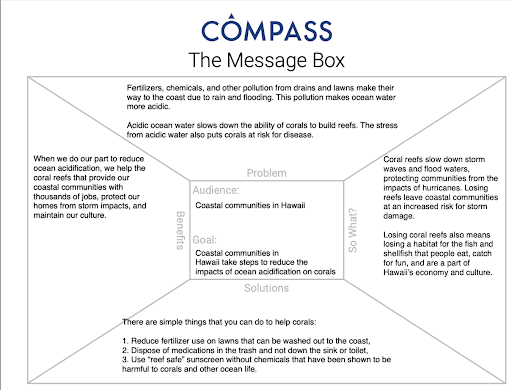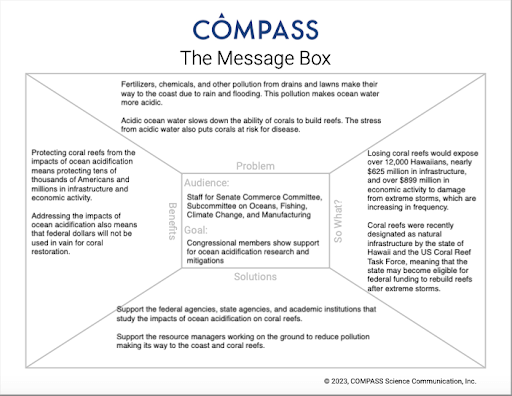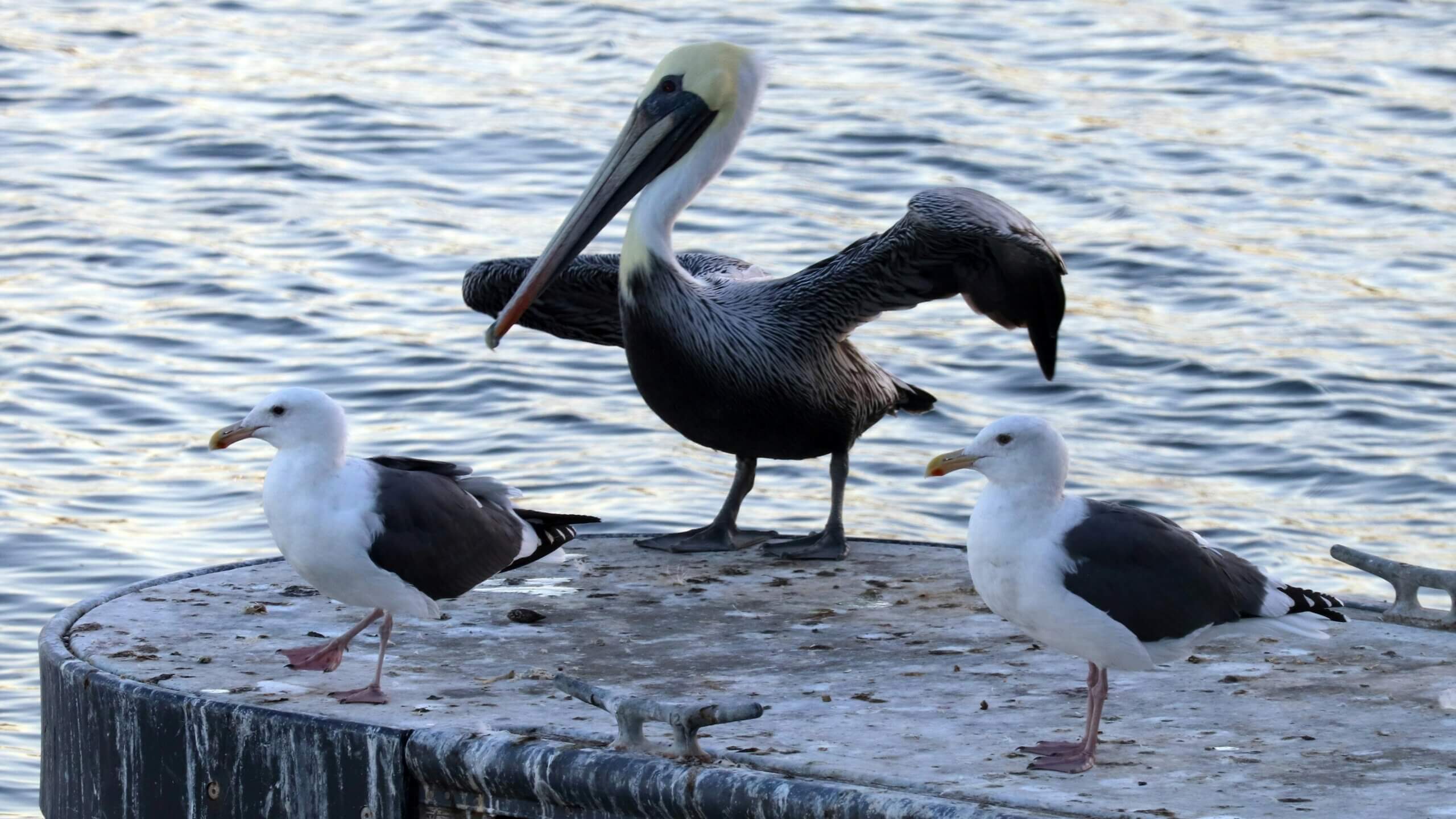Over the past 25 years, COMPASS has supported thousands of science professionals to effectively communicate about their work through interactive workshops, leadership programs, coaching sessions, and more. One principle that we touch on time and time again is the importance of adapting messages for different audiences. It may seem simpler to craft one message for everyone, but humans are complex and bring different values, priorities, and experiences to their interactions with you. Adapting your message for each audience addresses those differences and allows you to connect more deeply with them.
So the question then becomes: how do I know when to change my messaging for different audiences? And what specifically needs to change?
There are a variety of factors that impact when you should shift your messaging, including:
- Their Role
The reason you are communicating with this audience—the role you believe they play in addressing the issue—will vary across different audiences. - Their Motivation (what we call ‘so what?’)
Even if two groups could play a similar role in addressing the issue, their reason for taking action (or not) may vary. Their aspirations, concerns, values, and social ties will all impact how they interpret the information you share. - Cultural Context
An individual’s or group’s geography, age group, or primary language may impact the examples, metaphors, tone, or language that will connect with them. - Subject Familiarity
You may be able to go more in depth or use more detailed terminology with people who are more versed on the topic than those who are hearing about it for the first time.
Let’s look at an example!
I used the Message Box, COMPASS’ tool for distilling information into effective messages, to develop messaging for a scientist studying ocean acidification in Hawaii who wants to see their research applied to mitigate the impacts on coral reefs. For this topic, I identified two key groups that would be important for the scientist to engage with (1) coastal communities in Hawaii that directly interact with coral reef ecosystems, and (2) federal policy makers, specifically the Senate Commerce Committee’s Subcommittee on Oceans, Fishing, Climate Change, and Manufacturing. This subcommittee has jurisdiction over coastal zone management, and ocean activities. The subcommittee also oversees federal agencies that work on and make decisions about these topics, including the National Oceanic and Atmospheric Administration (NOAA).
A few things to note:
- Problem and Solution Messaging
While the problem can be shared the same way with both audiences, each audience has a unique opportunity to help address the issue. Therefore, we should adapt the “Solutions” messaging to highlight actions that each audience can do.
Hawaiian coastal communities are local to the area and have a direct impact on their environment. Therefore, when sharing possible solutions with this audience we can suggest on-the-ground action steps. On the other hand, the committee has influence on policy and funding decisions and can take actions to address the issue at a national level. - So What and Benefits Messaging
These audience have different experiences, motivations, and priorities that affect how they both perceive the impact of the problem and evaluate the proposed solution. Therefore, our ‘So What’ and ‘Benefit’ messaging should also be adapted to speak to what is most relevant for each group so that they can visualize why and how the issue impacts them.
Being local to the area means that the communities will be directly affected by the environmental impacts of ocean acidification, including increased storm impacts and job loss. So for this audience, it is important that our messaging addresses their priorities of safety, recreation, a strong economy, and the maintenance of culture. On the other hand, the congressional committee may need to hear impacts to lives and federal dollars at the broader scope of the state or national level. We also identified a recent natural infrastructure designation that presents a timely opportunity for the Committee.
Click the images below to view each audience’s individual Message Box or review them side-by-side in the table below.
Side-by-side comparison
| Communities | Committee | |
|---|---|---|
| Problem | Fertilizers, chemicals, and other pollution from drains and lawns make their way to the coast due to rain and flooding. The pollution makes ocean water more acidic. Acidic ocean water slows down the ability of corals to build reefs. The stress from acidic water also puts corals at risk for disease. | |
| Solution | There are simple things that you can do to help corals: 1) Reduce fertilizer use on lawns that can be washed out to the coast, 2) dispose of medications in the trash and not down the sink or toilet, 3) use “reef safe” sunscreen without chemicals that have been shown to be harmful to corals and other ocean life | Support the federal agencies, state agencies, and academic institutions that study the impacts of ocean acidification on coral reefs. Support the resource managers working on the ground to reduce pollution making its way to the coast and coral reefs. |
| So What | Coral reefs slow down storm waves and flood waters, protecting communities from the impacts of hurricanes. Losing reefs leaves coastal communities at an increased risk for storm damage. Losing coral reefs also means losing a habitat for the fish and shellfish that people eat, catch for fun, and are a part of Hawaii’s economy and culture. | Losing coral reefs would expose over 12,000 Hawaiians, nearly $625 million in infrastructure, and over $899 million in economic activity to damage from extreme storms, which are increasing in frequency. Coral reefs were recently designated as natural infrastructure by the state of Hawaii and the US Coral Reef Task Force, meaning that the state may become eligible for federal funding to rebuild reefs after extreme storms. |
| Benefits | When we do our part to reduce ocean acidification, we help the coral reefs that provide our coastal communities with thousands of jobs, protect our homes from storm impacts, and maintain our culture. | Protecting coral reefs from the impacts of ocean acidification means protecting tens of thousands of Americans and millions in infrastructure and economic activity. Addressing the impacts of ocean acidification also means that federal dollars will not be used in vain for coral restoration. |
Crafting messages for different audiences takes practice but is possible and is a great method for connecting with each audience. No matter the audience, remember to make sure that your messaging is moving you together towards your larger communication goal. What do you want to happen as a result of your engagement? For more guidance on articulating your reason for communicating and identifying your key audiences and their motivations, check out our Before the Message webinar and workbook.
Curious about how to share these messages at once? For example, at a community meeting that an elected official will attend? Check out our blog on communicating with multiple audiences simultaneously.





